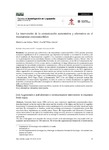La intervención de la comunicación aumentativa y alternativa en el traumatismo craneoencefálico

Use this link to cite
http://hdl.handle.net/2183/38637Collections
- Investigación (FEDU) [938]
Metadata
Show full item recordTitle
La intervención de la comunicación aumentativa y alternativa en el traumatismo craneoencefálicoAlternative Title(s)
Augmentative and alternative communication intervention in traumatic brain injuryDate
2018Citation
Gómez, Mª.L.; Pérez, E.Mª. (2018). La intervención de la comunicación aumentativa y alternativa en el traumatismo craneoencefálico. Revista de Investigación en Logopedia, 8(1), 43-62.
Abstract
[Resumen] Las personas que sobreviven a un traumatismo craneoencefálico (TCE) pueden presentar trastornos significativos de la comunicación que dependen del tamaño y severidad de la lesión y del nivel resultante de funcionamiento cognitivo. Los trastornos comunicativos generan una restricción en la participación en las actividades diarias y en la reintegración familiar, social y laboral. Ante las necesidades comunicativas insatisfechas derivadas de estos trastornos, el uso de la Comunicación Aumentativa y Alternativa (CAA) es una opción a considerar a lo largo del proceso de recuperación para compensar las necesidades temporales o permanentes, y llevar al máximo potencial la comunicación para la interacción social. El objetivo de este artículo es presentar la variedad de herramientas y estrategias de CAA para una buena valoración e intervención de los supervivientes a un TCE, siguiendo el marco organizativo de estrategias de intervención que incluye los niveles de estimulación, de estructuración y compensatorio, y no las tradicionales fases del modelo de recuperación, y que ha sido descrito en esta área de trabajo por Fager y sus colaboradores (Fager, 2005; Fager y Beukelman, 2005; Fager y Karantounis, 2010; Fager, Doyle, y Karantounis, 2007). Con este trabajo se pretende realizar una contribución a la intervención logopédica, en tanto en cuanto no existen documentos en español que describan y resuman las diferentes estrategias de valoración e intervención de la CAA en población con daño cerebral por TCE. [Abstract] Traumatic brain injury (TBI) survivors may experience significant communication disorders that depend on factors such as the extent and the severity of the injury, and the level of cognitive functioning. Communication disorders restrict participation in conversation and daily functional tasks and limit the reintegration to familiar, social and working environments. Communication needs that stem from these impairments are usually unmet. Hence, the Augmentative and Alternative Communication intervention is an option for consideration along recovery process to compensate for temporal or permanent communicative needs and in an attempt to maximize communication function for social interaction. The aim of this paper is to describe the variety of AAC tools and strategies for a successful AAC assessment and intervention for TBI survivors. We follow the organizational framework of interventions strategies proposed by Fager et al. (Fager, 2005; Fager & Beukelman, 2005; Fager & Karantounis, 2010; Fager, Doyle, & Karantounis, 2007) that include the Stimulation Level, Structured Level and Compensation Level, rather than the traditional phases of recovery model. This study aims to contribute to Speech and Language Therapy intervention insofar as there are no materials written in Spanish that describe and summarize the variety of AAC assessment and intervention strategies in the traumatic
brain-damaged population.
Keywords
Traumatismo craneoencefálico
Trastorno de la comunicación
Comunicación aumentativa y alternativa
Valoración
Intervención
Traumatic brain injury
Communication impairment
Augmentative and alternative communication
Assessment
Intervention strategies
Trastorno de la comunicación
Comunicación aumentativa y alternativa
Valoración
Intervención
Traumatic brain injury
Communication impairment
Augmentative and alternative communication
Assessment
Intervention strategies
Editor version
Rights
Atribución 3.0 España
ISSN
2174-5218






